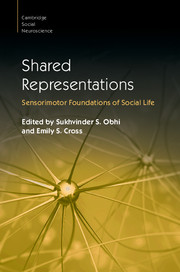Book contents
- Shared Representations
- Cambridge Social Neuroscience
- Shared Representations
- Copyright page
- Contents
- Figures
- Tables
- Boxes
- Contributors
- Preface
- Part I Foundations
- Part II Imitation and Mimicry
- 6 The Comparative Study of Imitation Mechanisms in Non-Human Primates
- 7 The Cultural Transmission of Social Information
- 8 The Control of Shared Representations and Social Cognition
- 9 Neurocognitive Explorations of Social Mimicry
- Part III Thinking, Perceiving and Acting with Others
- Part IV Understanding Others
- Part V Learning and Development
- Part VI Shared Representations in Applied Contexts
- Index
- Plate Section (PDF Only)
- References
7 - The Cultural Transmission of Social Information
from Part II - Imitation and Mimicry
Published online by Cambridge University Press: 27 October 2016
- Shared Representations
- Cambridge Social Neuroscience
- Shared Representations
- Copyright page
- Contents
- Figures
- Tables
- Boxes
- Contributors
- Preface
- Part I Foundations
- Part II Imitation and Mimicry
- 6 The Comparative Study of Imitation Mechanisms in Non-Human Primates
- 7 The Cultural Transmission of Social Information
- 8 The Control of Shared Representations and Social Cognition
- 9 Neurocognitive Explorations of Social Mimicry
- Part III Thinking, Perceiving and Acting with Others
- Part IV Understanding Others
- Part V Learning and Development
- Part VI Shared Representations in Applied Contexts
- Index
- Plate Section (PDF Only)
- References
Summary
Human groups differ not only in the types of tools and artifacts they produce, but also in the ways in which they interact with and behave around each other. Social learning is key to explaining these differences between human groups. However, to date, research on cultural transmission has focused predominately on how imitation and other forms of social learning enable children to learn about the physical world. While this research has yielded important insights into the nature of the cultural transmission process, the picture it provides is incomplete. Here, inspired by anthropological perspectives, we adopt a broader view of culture and emphasize that a group’s culture is not only composed of the tools and artifacts it produces but also the values, norms, attitudes, opinions and beliefs that it holds dear. Using this broader definition of culture, we review the social psychological literature on how children learn about the social world through copying those around them. We hope this integrative review highlights the importance of the more social aspects of cultural transmission and offers a broader view of human culture that will open up new avenues for future research.
- Type
- Chapter
- Information
- Shared RepresentationsSensorimotor Foundations of Social Life, pp. 136 - 150Publisher: Cambridge University PressPrint publication year: 2016
References
- 2
- Cited by



